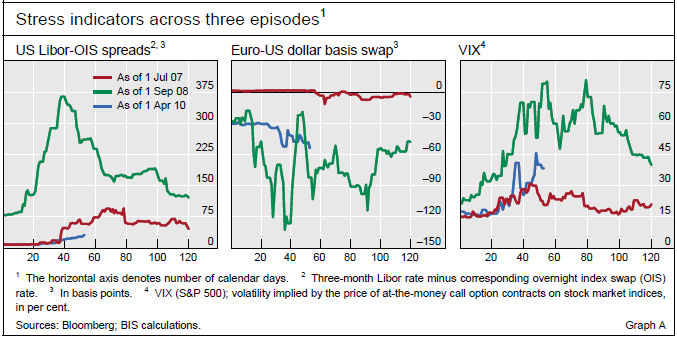Back to the future? Comparing recent events with the 2007-09 financial crisis
(Extract from page 6 of BIS Quarterly Review, June 2010)
The swift reversal in market confidence evokes painful memories of autumn 2008, when the collapse of Lehman Brothers brought money and capital markets to a virtual standstill. In both cases market sentiment deteriorated rapidly around a trigger event, with problems in one region spreading globally through the network of interbank funding markets and counterparty credit exposures. Volatility jumped, and the prices of risky assets fell sharply as investors moved into perceived safe havens. In both episodes, central banks provided exceptional funding liquidity, and government rescue packages were subsequently announced with a view to restoring market confidence and stabilising the financial system.
While the broad outlines are similar, the Greek downgrade on 27 April and the subsequent market reaction may have more in common with the start of the subprime crisis in July 2007 than the collapse of Lehman Brothers in September 2008. That crisis began slowly with the disclosure of mounting losses on subprime mortgages and the downgrade by rating agencies of a large number of mortgage-backed CDOs. Similarly, emerging losses at several European banks were followed by a widening of Libor-OIS spreads (Graph A, left-hand panel). Over the next few months, European banks faced difficulties in funding their US dollar portfolios, as seen in the dislocation in cross-currency swap markets from September 2007 onwards (Graph A, centre panel). While equity prices continued to rise up to mid-October, implied equity market volatility increased from July onwards, as reflected in the upward trend of the VIX (Graph A, right-hand panel).
The current market stress has been associated with the same increase in equity volatility as in the second half of 2007, but Libor-OIS spreads have moved up more slowly. Despite the recent rise to around 30 basis points, three-month US dollar Libor-OIS spreads remain well below their levels from August 2007 onwards. The current rise in the VIX initially followed the July 2007 trajectory, but then jumped sharply, as it did in September 2008. While cross-currency basis swaps are signalling difficulties for banks seeking to raise US dollars, the limited participation at US dollar auctions held by the ECB, the Bank of England and the Swiss National Bank suggests that the problem is more about counterparty credit risk than access to foreign currency funding. In contrast to July 2007, the euro-US dollar basis swap began the recent period at a level suggesting that stress was already present in cross-currency funding markets. The current departure point was similar to that of early September 2008, but the spread has widened by much less this time in response to worsening market conditions.


